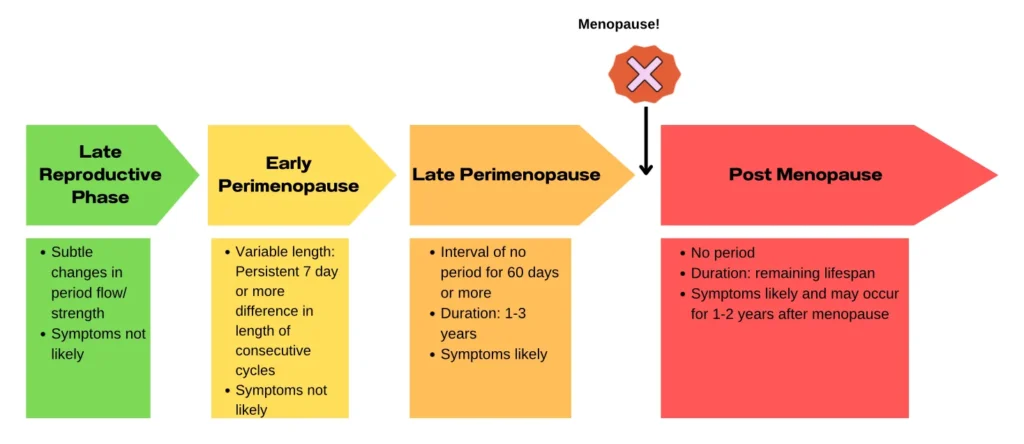Understanding perimenopause can be overwhelming, and often times providers explain it in a confusing way that makes it difficult to remember. That’s why we’ve turned it into a story — one that reflects the experiences, challenges, and insights many women face during this menopausal transition. As we journey through Ashka’s story, imagine yourself in her shoes, walking through the changes with her.
The Journey Through Perimenopause: Ashka’s Story
Ashka had always been the planner in her family. She mapped out every vacation, scheduled her children’s extracurriculars months in advance, and even had a five-year career plan that got her to where she was now. With her 50th birthday around the corner, nothing could have prepared her for the unexpected premenopausal symptoms should would be facing.
Am I in Perimenopause?
About a year ago, Ashka started noticing inconsistencies with the length of her period. It started off being a day or two late which she paid no mind to, knowing that a stressful week with the kids might make that happen. As time went on so did the fluctuations with her cycle. Sometimes her cycle would be over a week late which brought some worries, but her busy life seemed to take her attention away from thinking too much about it.
One morning, Ashka woke up drenched in sweat. She had kicked off the covers in the middle of the night, something she barely remembered doing. At first, she naturally blamed stress again, but as the months went on, the hot flashes, mood swings, and irregular menstrual cycles became impossible to ignore. She knew she needed to seek some professional help.
Perimenopause, often called the menopausal transition, is the stage leading up to menopause. Typically, the average age for perimenopause to start is between 45 and 54 years old. Menopause is defined as a single day after 12 consecutive months without a menstrual cycle. Unlike menopause, perimenopause occurs over a variable amount of time. It’s marked by hormonal fluctuations that cause symptoms like night sweats, mood swings, and cycle irregularities. (1)
The Stages of Perimenopause: Understanding the Transition
Ashka had been seeing a dietitian who introduced her to the Stages of Reproductive Aging Workshop (1), a well-known system that categorizes the journey to menopause into clearly defined stages:

Reproductive Stage
- Late Reproductive Stage: Even before her cycles became irregular, Ashka began experiencing subtle signs like changes in menstrual flow and occasional mood swings. At this stage, her periods were still regular, and most of her hormone levels remained steady. However, a hormone called AMH, which helps measure egg supply, had started to decline. This was a sign that her ovaries were beginning to slow down. (1)
Perimenopause (Menopausal Transition)
- Early Perimenopause: Around the age of 46, Ashka’s cycles started to vary by more than seven days in length. Usually her cycles would last for 28 days, but now they last anywhere from 38-45 days. She seems to only get her period every other month or so. Along with less frequent periods, Ashka started experiencing night sweats and heightened anxiety. She asked to get her hormones tested, but there didn’t appear to be any significant changes. Her doctor told her that it’s common at this stage for hormones to fluctuate up and down like a roller coaster, so a single test might not capture the full picture. Because of this, lab results appear “normal” even when symptoms are anything but. (1)
- Late Perimenopause: By her late 40s, Ashka began skipping periods for months at a time. Her hot flashes persisted, and symptoms like brain fog and sleep disturbances became more frequent. Concerned, she visited her provider, who checked her hormone levels and noticed that her FSH was rising. FSH, or follicle-stimulating hormone, plays a key role in regulating the menstrual cycle. During perimenopause, the brain signals the ovaries to work harder—almost like a last-ditch effort to release an egg. This results in surging FSH levels. (1)
Menopause
- Ashka’s provider explained that the day she reaches 12 months without a period, she will have officially entered menopause. Her provider explained that menopause itself is a single point in time—the anniversary of her last menstrual period. (1)
Postmenopause
- Early Postmenopause: Over the next two years after menopause, Ashka was told she could continue experiencing hot flashes from perimenopause, and her hormone levels would adjust to new baseline levels. (1)
- Late Postmenopause: As Ashka moves further beyond menopause she will stay within the Late postmenopause stage. Her dietitian expressed during this time she would want to focus on long-term health goals for postmenopausal women such as building bone density, preventing heart disease, and maintaining cognitive function. (1)
Managing Perimenopause Symptoms: Hot Flashes, Mood Swings, and More
No two women experience perimenopause the same way, and Ashka’s journey was no exception. Some days, she felt fine. Other days, she could barely focus, battling brain fog, irritability, and overwhelming fatigue.
Understanding Hormonal Changes During Perimenopause
As her estrogen & progesterone levels fluctuated, Ashka noticed:
- Hot Flashes and Night Sweats: The hallmark symptoms of perimenopause.
- Sleep Disruptions: She often found herself tossing and turning, unable to stay asleep.
- Irregular Periods: Sometimes light, sometimes heavy, sometimes absent.
Emotional and Cognitive Changes
Ashka had always been level-headed, but now, she was riding an emotional rollercoaster:
- Perimenopause Anxiety & Mood Swings: The smallest inconveniences left her either in tears or furious.
- Brain Fog during Perimenopause: She found herself walking into rooms and forgetting why she was there.
Long-Term Health Considerations With Perimenopause
During her session, her dietitian explained that estrogen plays a vital role in bone health, cardiovascular health, and even cognitive function. With declining estrogen levels, women going through perimenopause face an increased risk of osteoporosis, heart disease, and metabolic changes like increased body fat. (2)
Women who have experienced postmenopause have a higher risk of developing osteoporosis, a disease that weakens bones. Research shows that within 5 years of menopause the average woman’s bone mineral density can decline up to 10% in the spine. (2) Many of our patients are unaware of how significant this bone loss can be and the increased risk it poses on their health.
But there was good news: lifestyle changes and interventions could help ease the transition. Although it was a lot of information to take in, Ashka was excited to look into different ways to help her along her journey so she could be proactive when tackling her menopausal symptoms & prevent future chronic disease.
Navigating the Stages of Perimenopause
Though the menopausal transition was challenging, Ashka found comfort in finally understanding what was happening to her body. Perimenopause wasn’t something to fear—it was a natural transition, and with the right support, she realized she didn’t have to face it alone. While this phase of life can be difficult, you don’t have to simply endure your perimenopausal symptoms or accept them as your fate. Solutions and support are available to help you navigate this time with greater ease and confidence.
For women going through perimenopause, knowledge is power. Understanding the stages, symptoms, and treatment options can make all the difference in navigating this complex transition.
As you saw with Ashka, perimenopause affects every woman differently, with symptoms that can shift from year to year and even day to day. That’s why personalized care is essential—there’s no one-size-fits-all solution. At our private practice, we’re here to listen, understand your individual needs, and offer tailored support.
Don’t wait to take control of your health— schedule an appointment with us today or explore more on our website to discover how we can help you.
References
- Casper RF. Clinical manifestations and diagnosis of menopause. Barbieri RL, Crowley WF, Martin KA, eds. Published online June 29, 2023. Accessed February 12, 2025.
- Finkelstein JS, Brockwell SE, Mehta V, et al. Bone Mineral Density Changes during the Menopause Transition in a Multiethnic Cohort of Women. The Journal of Clinical Endocrinology & Metabolism. 2008;93(3):861-868. doi:https://doi.org/10.1210/jc.2007-1876


